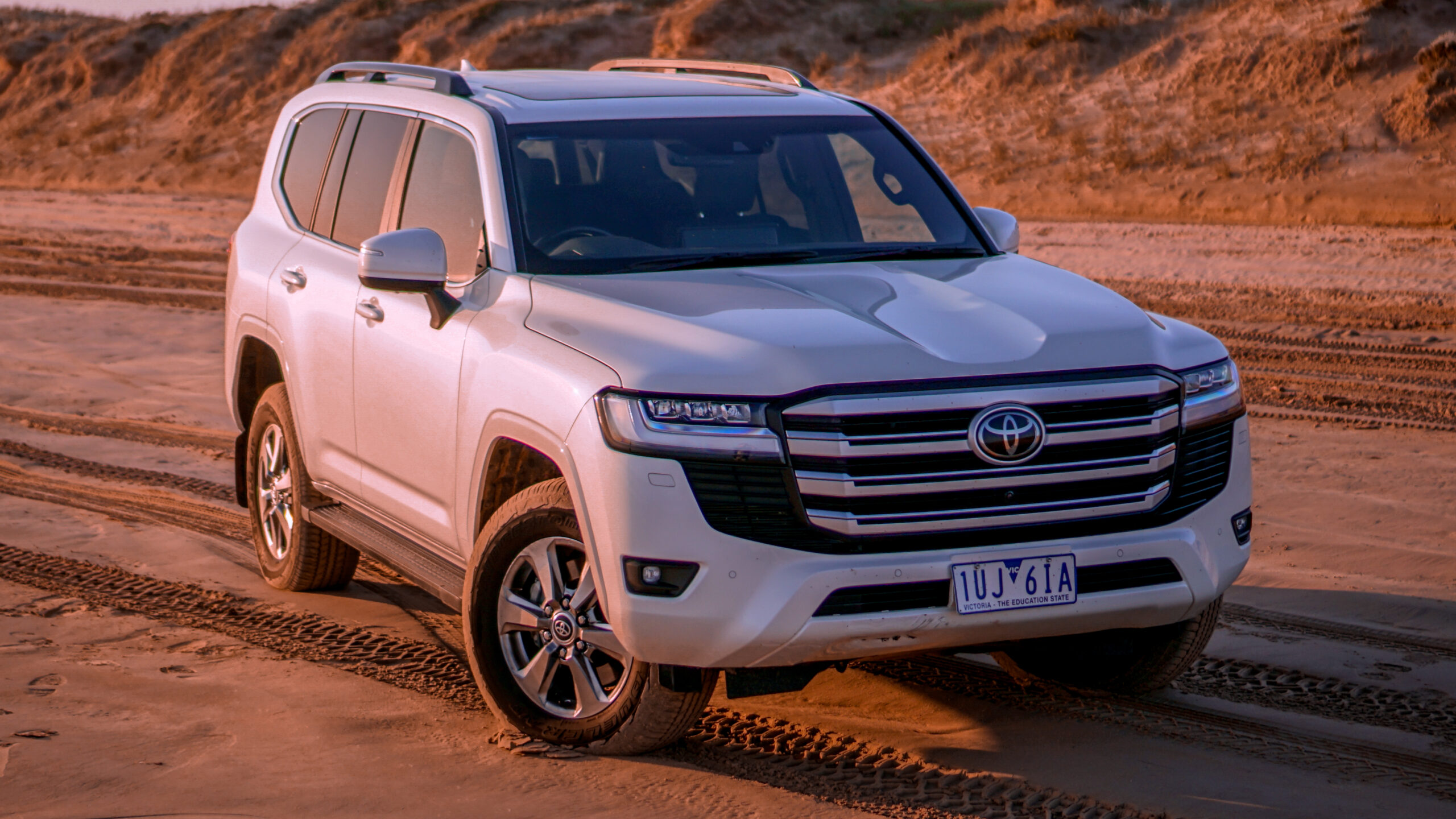What can one say about the 2022 Toyota Land Cruiser? It’s a vehicle that serves dual purposes. It’s a part-time off-roader and a full-time school-run status symbol. It’s also the darling of the Australian highways, tugging boats and caravans for miles in quiet dignity.
Last year, Toyota delivered the brand-new 300 Series to market (excluding the North American one) to relieve its much-adored predecessor after 13 years in production. While the 200 Series didn’t catch on in the United States, it remained in high demand in markets like Australia and the Middle East right up until its demise. It boasted an agreeable ride and great towing capability while remaining a highly capable off-road platform despite its creature comforts. The 200 Series is a hard act to follow, with the diehard fanbase already decrying the new model’s lack of a V8 engine.
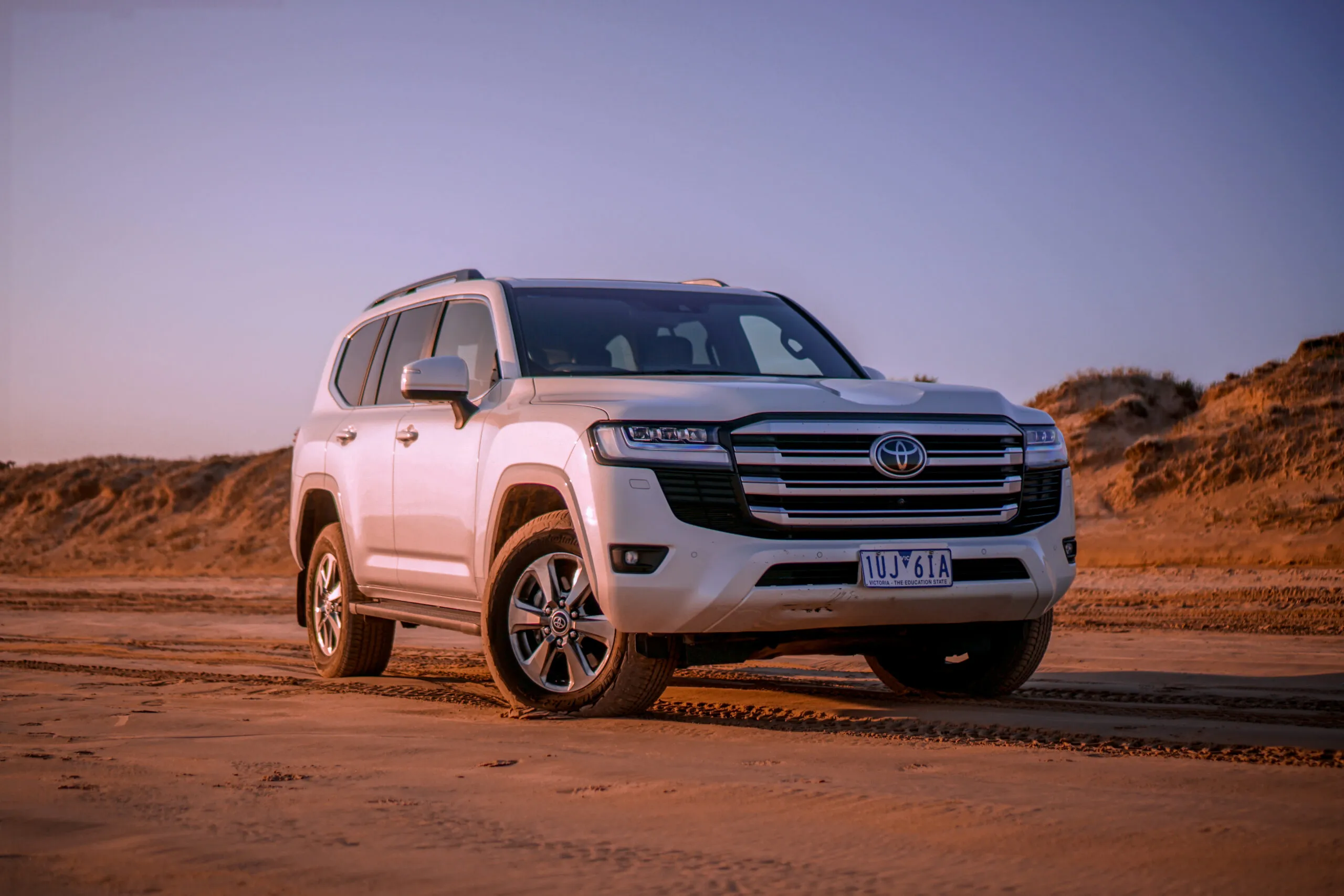



For the 300 Series, Toyota had to do the same again, but better. The Land Cruiser needed to move with the times without compromising on what made the model so beloved to begin with. Does the new kid on the block measure up? That’s what I intended to find out.
2022 Toyota Land Cruiser Review Specs
- Base price (as tested): $96,025 AUD ($120,985 AUD)
- Powertrain: 3.3-liter twin-turbocharged diesel V6 | 10-speed automatic | four-wheel drive
- Horsepower: 304 @ 4000 rpm
- Torque: 516 lb-ft @ 1,600 to 2,600 rpm
- Cargo volume
- Minimum 6.2 cubic feet with 7 passengers
- 35.5 cubic feet with third row folded
- Maximum 69.5 cubic feet with second and third row folded
- Ground clearance: 9.25 inches
- Off-road angles: 32º approach | 21º breakover | 25º departure
- Curb weight: 5,798 pounds
- Australian fuel economy: 21 mpg urban | 31 extra urban | 26 combined
- Quick take: Just as happy hauling down a rutted trail as it is rolling up to the mall with kids in tow.
- Score: 8/10
The Basics
Toyota split the Land Cruiser lineage into two streams long ago. The original 40 Series was dedicated to off-road duties, while the 50 Series launched in 1967 with a greater focus on passenger comfort and on-road manners. Today, the 70 Series serves in the former role, receiving only minor refreshes since the 1980s. The comfort-oriented models have seen more regular updates to serve market trends, with the 300 Series being the latest in line. Toyota’s challenge is to improve on perfection.
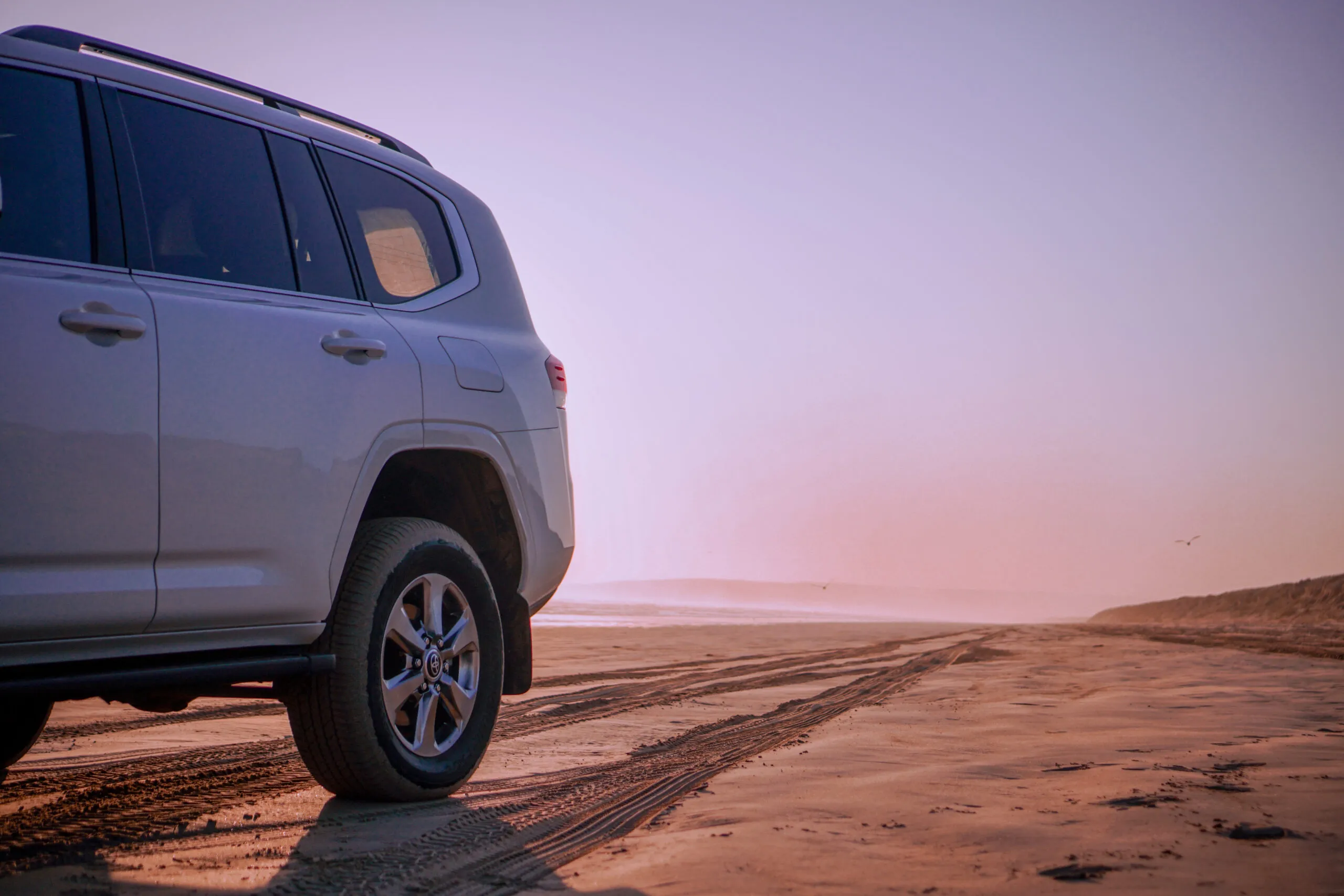


On the outside, the 300 Series is unmistakably still a Land Cruiser. It’s got the usual two-box design, but it’s a little more slab-sided than the outgoing model. The bumper, sills, and body lines give it a brick-like, squared-off appearance. It brings the Land Cruiser into line with the rest of Toyota’s current range and follows the same design language. Overall, it’s a fairly conservative look; relatively timeless in the vein of so many other Land Cruisers past.
The 300 Series has also made a huge leap inside, too. The new layout is simpler, more modern, and a showcase of how far car interiors have come in the past decade. It seamlessly integrates screens into the dash, while still retaining physical buttons for important functions and real dials on the gauge cluster. It’s new and fresh without being pointlessly futuristic for the sake of it. A sage choice, given the model’s golden market of wealthy caravan-toting retirees (in Australia, at least).
Perhaps the most controversial decision Toyota made was dropping the V8. Where the outgoing model featured a range of gasoline or diesel V8 options depending on the market, the 300 Series eschews all that for V6 power across the range. Australia only gets the 3.3-liter turbodiesel, while a 3.4-liter turbo and 4.0-liter naturally aspirated V6 are available in other markets. Regardless of purists getting upset, the new engines are the way of the future. They make more power than their larger predecessors, and, with the aid of the new 10-speed automatic transmission, they’re more efficient, too. Given the hell that is today’s fuel prices, that’s a welcome addition.




It’s still a Land Cruiser at its heart. But, crucially, it’s a new hit single, where the outgoing model was starting to feel a little bit more like Toyota’s Greatest Hits.
Driving the Toyota Land Cruiser 300
Entering the 300 Series tells you everything about how it differs from its work-a-day 70 Series cousin. Where the latter opens with a metallic clank, the 300 Series door opens with the quiet whump of a velvet-lined cigar case. The doors have a luxurious heft to them, shutting with a weighty thud and sealing you in the well-insulated interior. Inside your cocoon, it feels as though you could sit quietly as a street fight raged outside without being unduly perturbed.
One doesn’t so much drive the Land Cruiser as pilot it from the helm. That’s how it felt to me, anyway, and I really thought I deserved a captain’s hat to go with it. Sitting in the plush seats, you fire up the engine with a touch of a button and pop the transmission in Drive with the low-profile shifter. It takes only a tickle to get the diesel rumbling, and the Cruiser effortlessly glides away at your command. Everything the Land Cruiser does feels easy. Simply leaning into the pedal is enough for most overtaking duties, while barrelling along at highway speeds is no trouble at all. It’s by no means fast, but nor does it ever feel slow. With so many gear ratios and all that torque on tap, you simply waft up to speed while the diesel growls in agreement.




You sit high over traffic. The combination of the engine and the perfectly weighted steering wheel makes driving feel easy. You have excellent visibility and the power to easily keep up with traffic, while the vehicle’s size makes you feel like everyone will give you the room you need. Plus, potholes and curbs are really no trouble; you can simply drive over them if you really feel like it. The ride is more truck-like than a typical sedan, and certainly not luxury-car smooth, but one suspects Land Cruiser buyers like the mildly rough-and-tumble feeling of a rugged machine, anyway.
It’s easy to understand why the Land Cruiser is a darling of school-aged families. There’s ample room to throw the kids and their gear in the back, and even with five aboard, it doesn’t feel cramped. Plus, it makes getting around easy. Merging is easy, and you don’t fear getting rolled over by other road users in the way you might in a Volkswagen Up or Hyundai Getz. No, quite the reverse; they probably fear you.
Whether it’s weekend sports or a trip to the mall, it really is a great companion. The only time you’ll suffer is when it comes time to park. The parking sensors and 360-degree camera will help, but there’s no getting around it: This is a big vehicle. The turning circle is pretty good, though, so if you have to bail out and do a U-turn, you should do fine.





One might ask the question, then—why would anyone choose a Land Cruiser over a lighter, more efficient crossover? Well, as good as the Land Cruiser is around town, it’s also a bloody pearler beyond it, too.
It’s the same story on road and off; the Land Cruiser just makes driving easy. Out on a dirt road, you’ll find yourself comfortably driving along at 60 mph without the slightest care in the world. It’s simply unbothered.
I was duly impressed when putting the Cruiser through its paces out on the sand. All I did was drop the tire pressures and put it in “Sand” mode before heading out to the beach. It freely motored along without a second thought. I had no need to micromanage the gear selection or even be particularly careful about my lines. It just plowed on through, unfussed. Even the deeply-rutted softer sections posed no trouble.
I didn’t even get to trying out the full wealth of off-roading gizmos that Toyota includes these days. For tougher situations, though, it’s well-equipped, with everything from hill descent control to a complicated multi-function crawl mode I couldn’t quite figure out. True to its status as a proper off-roader, you’ve also got proper low-range available for when you’re really in the thick of it.







That’s really the beauty of the Land Cruiser, though. It’ll cosset you, whisking you around town in quiet comfort without complaint. It’ll then ford a stream, get up a greasy, rocky pass, and carry you through a mud pit to the next town over. It only asks to be hosed down before it takes you dinner, as much for its own dignity as yours.
The Highs and Lows
The good points of the Land Cruiser are all obvious from the drop. It’s a big car that coddles you on the road and gets you where you’re going off-road. It’s got a great powertrain, a spacious and comfortable interior, and cavernous storage in the back if you’re not using (or not equipped with) the third-row seats.
Toyota’s efforts to bring the Land Cruiser into today have also paid off. The buttons, switches, and interfaces are all nice and modern and with a quality feel. The interior in general is genuinely a nice place to be, whether you’re driving around or simply sitting around in a carpark. I spent plenty of time in the 200 Series during my time in the ag industry, and they were a great mobile office or just somewhere to chill and eat lunch. The 300 Series has nailed that in the same way.


However, the Land Cruiser isn’t without its drawbacks. For a start, there’s the price. In most configurations, the Land Cruiser is a six-figure car, and yet despite that, you don’t always get a whole lot of equipment. The VX trim I tested had no tire pressure sensors, nor a head-up display, both of which felt like a harsh exclusion. You’d get gear like that on a $65,000 Hyundai, and its absence is really felt here. The base model is just a tick under $100,000 and doesn’t get parking sensors. Obviously, Toyota feels the need to differentiate higher-end models with more equipment, but there’s a limit.
Fuel consumption is another place where the Land Cruiser doesn’t shine, depending on your point of view. It’s not a surprise, really, given the sheer size and weight of the vehicle, but it’s something to consider, nonetheless. I averaged 21 mpg during the review period, bang on Toyota’s own figures for city driving. That’s not bad for a large SUV, but if you’re using this as the family school bus, take into account the hit to your hip pocket.




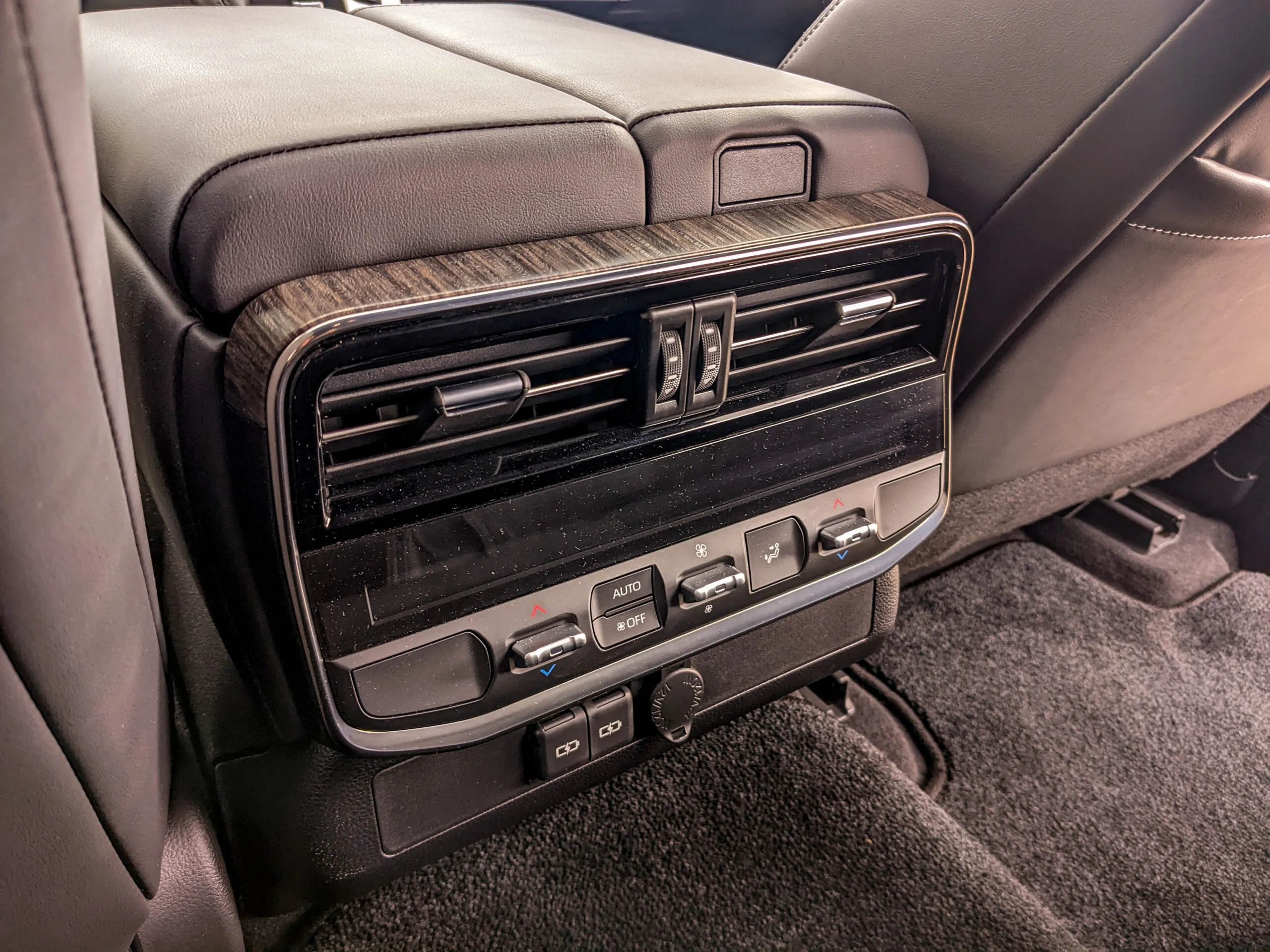

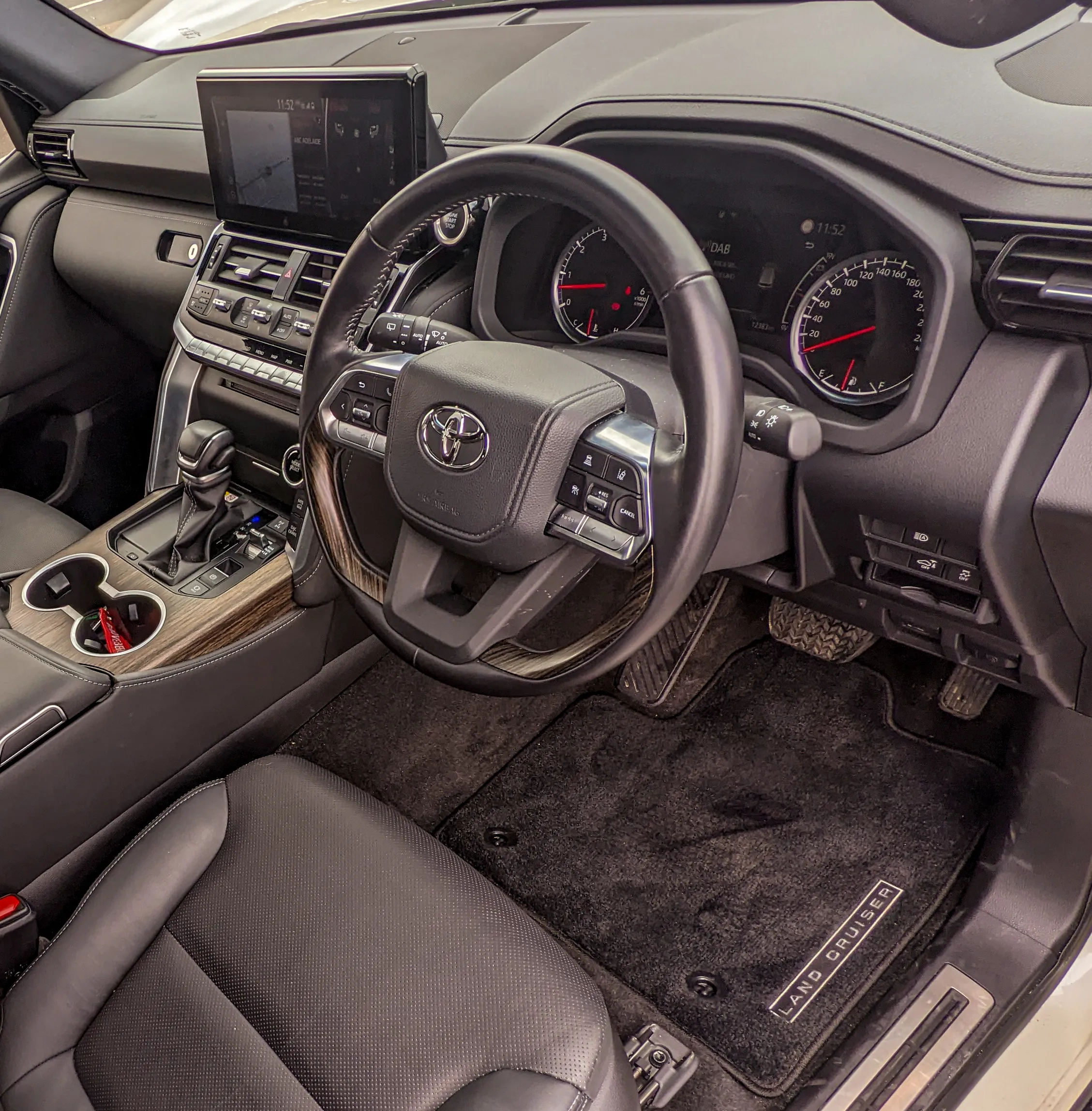
Finally, parking is also a little tough, given the sheer size of the vehicle. Visibility is good and the sensors and cameras help, but they can only do so much when you’re trying to cram into a tight space. However, plenty of people manage to tuck these into tight mall carparks weekend in, weekend out, so you probably adjust in due time.
Toyota Land Cruiser 300 Features, Options, and Competition
The base model starts at $96,025 AUD, with cloth trim, vinyl floors, and no third-row seating. There’s only a nine-inch touchscreen with no sat-nav, and the interior light is a halogen rather than an LED, even if stocking an extra type of globe probably costs Toyota more than it saves. Stepping past the GXL to the mid-range VX model seen here, and you get a bit more kit for your $120,985 AUD. Toyota throws in a terrain camera for better vision off-road, upgraded synthetic seats, a 12.3-inch touchscreen and a moonroof, among other niceties.
Features like a head-up display, power-lift rear door, and tire pressure sensors are available on higher-tier models, but you’ll pay for them. The best-equipped trims are the Sahara ZX ($146,777) and the off-road-focused GR Sport ($145,737). They also get heated and ventilated second-row seats, driver’s seat memory, and leather-accented seats.



Toyota can afford to charge these figures, though, because there simply isn’t much competition. The Mitsubishi Pajero is long gone, leaving the Nissan Patrol as its only main rival. While luxury off-roaders like the Land Rover Defender and Mercedes-Benz G-Wagen do exist, they’re generally considered a separate segment of the market. The same goes for the Jeep Wrangler—it’s failed to find fans with either school-aged families or caravan-toting gray nomads, the die-hard fanbases that keep the Land Cruiser going.
The Nissan Patrol comes in two trims, the Ti at $89,602 and the Ti-L at $103,202. Even the Ti has more equipment than the cheapest Land Cruiser, including power seats, automatic headlights, parking sensors, and tire pressure monitoring. The Ti-L adds in a sunroof, power tailgate, second-row entertainment, and a 13-speaker Bose sound system. You’d have to spend close to $40,000 more to get similar gear on the Toyota. So, the Patrol comes at a significant discount compared to the Land Cruiser. However, the Y62 model Patrol was first launched in 2010. It’s starting to show its age and lacks now-common features like Apple CarPlay and Android Auto.
A combination of the price and availability means the Patrol has actually outsold the Land Cruiser in Australia for several months in 2022. Don’t expect it to last, though. In 2020 and 2021, Land Cruisers outsold Patrols by three to one. When Toyota gets its supply situation sorted out, expect normality to resume. The Patrol simply doesn’t have the same badge power as the legendary Land Cruiser, even if it’s the only one with a V8 on the market.




Overall, the Land Cruiser is one of those vehicles that doesn’t really have peers. For some muscle car fans, only a Mustang will do, and it’s the same case for many with Toyota’s off-roader. It’s a great vehicle, it just doesn’t come cheap. Toyota’s waiting list indicates that plenty of people are willing to pay the price for the quality.
Value and Verdict
Fundamentally, the Land Cruiser has earned its reputation. It’s a comfortable vehicle that’s happy doing whatever, with serious capability hidden up its sleeve. Whether you’re just hauling kids around, taking the dogs out for a hike, or going deep into the bush, it’ll do all that with aplomb.
However, it is an aspirational vehicle for a reason. It’s neither cheap to buy, nor cheap to run, and in a way, that’s why it’s a status symbol. You can have it all with a Land Cruiser, that’s for sure—and the badge lets everyone know you’re willing to pay for it.
Got a tip? Let the author know: lewin@thedrive.com
